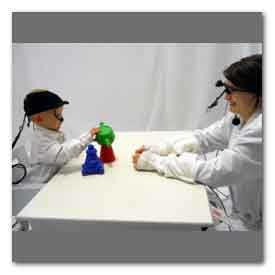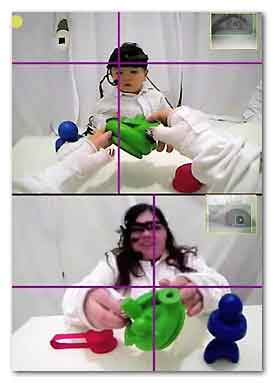|
Eye-tracking study first to suggest connection
between caregiver focus and key cognitive
development indicator in infants: parents who turn
to smartphones and tablets to break up the tedium of
caring for an infant around the clock may be
teaching their babies to have a short attention
span, according to a new study by psychologists at
Indiana University.

Head-mounted cameras enabled psychologists to track
how the movement of caregivers' eyes affected
infants' attention. Photo by Chen Yu
This combination of malaria protein and toxin seeks
out the cancer cells, is absorbed, the toxin
released inside, and then the cancer cells die. This
process has been witnessed in cell cultures and in
mice with cancer. The discovery is described in an
article in Cancer Cell.
Ali Salanti’s team is currently testing a vaccine
against malaria on humans, and it was in connection
with the development of this drug that he discovered
that the carbohydrate in the placenta was also
present in cancer tumors. Ali Salanti immediately
contacted his former fellow student and now cancer
researcher, Mads Daugaard, who is head of the
Laboratory of Molecular Pathology at the Vancouver
Prostate Center at UBC in Canada. In collaboration,
the two groups have generated results, which they
hope will provide the basis for a drug gainst
cancer.

The top image shows an infant from the caregivers'
point of view. The lower image shows a caregiver
from the infants' point of view. The crosshairs
indicate the focus of the eyes. Photo by Chen Yu.
The work, which appears in the journal Current
Biology, is the first to show a direct connection
between how long a caregiver looks at an object and
how long an infant’s attention remains focused on
that same object.
"The ability of children to sustain attention is
known as a strong indicator for later success in
areas such as language acquisition, problem-solving
and other key cognitive development milestones,"
said Chen Yu, who led the study. "Caregivers who
seem distracted or whose eyes wander a lot while
their children play appear to negatively impact
infants' burgeoning attention spans during a key
stage of development."
Yu is a professor in the IU Bloomington College of
Arts and Sciences' Department of Psychological and
Brain Sciences. Linda Smith, IU Distinguished
Professor and Chancellor's Professor of
Psychological and Brain Sciences, is co-author on
the paper.
"Historically, psychologists regarded attention as a
property of individual development," Smith said.
"Our study is one of the first to consider attention
as impacted by social interaction. It really appears
to be an activity performed by two social partners
since our study shows one individual's attention
significantly influence another's."
Thanks to head-mounted cameras worn by both
caregivers and infants in the study, IU scientists
got a first-person point of view on parents and
children playing together in an environment that
closely resembled a typical play session at home or
day care. The technology also allowed the parents
and children to play with physical toys. A typical
eye-tracking study of children would involve
manipulating objects on a screen.
Caregivers were given no instructions before
engaging with children to ensure the psychologists
got an unfiltered view of their interactions.
Generally, Yu said, caregivers fell into two major
groups: those who let the infants direct the course
of their play and those who attempted to forcefully
guide the infants' interest toward specific toys.
"A lot of the parents were really trying too hard,"
he said. "They were trying to show off their
parenting skills, holding out toys for their kids
and naming the objects. But when you watch the
camera footage, you can actually see the children's
eyes wandering to the ceilings or over their
parents’ shoulders -- they're not paying attention
at all."
The caregivers who were most successful at
sustaining the children’s attention were those who
"let the child lead." These caregivers waited until
they saw the children express interest in a toy and
then jumped in to expand that interest by naming the
object and encouraging play.
"The responsive parents were sensitive to their
children's interests and then supported their
attention," Yu said. "We found they didn't even
really need to try to redirect where the children
were looking."
The gains in attention for children in this group
were significant. In cases where infants and
caregivers paid attention to the same object for
over 3.6 seconds, the infant’s attention lingered
2.3 seconds longer on average on the same object
even after the caregiver's gaze turned away. This
extra time works out to nearly four times longer
compared to infants whose caregivers' attention
strayed relatively quickly.
The impact of a few seconds here and there may seem
small. But when they are magnified over a play
session - and those play sessions occur over months
of daily interaction during a critical stage in
mental development - the outcomes grow
significantly, Yu said.
A number of other studies tracking the influence of
sustained attention in children from ages 1 through
grade school show consistently that longer attention
spans at an early age are a strong predictor of
later achievement.
The shortest attention spans in the study were
observed in a third group, in which caregivers
displayed extremely low engagement with children
while playing. These distracted caregivers tended to
sit back and not play along, or simply look
elsewhere during the exercise.
"When you’ve got a someone who isn't responsive to a
child's behavior," Yu said, "it could be a real red
flag for future problems."
This research was supported by the U.S. National
Institutes of Health.
For more information
Current Biology
The Social Origins of Sustained Attention in
One-Year-Old Human Infants
Chen Yu, Linda B. Smith
Link...
Indiana University Bloomington
Link...
MDN |